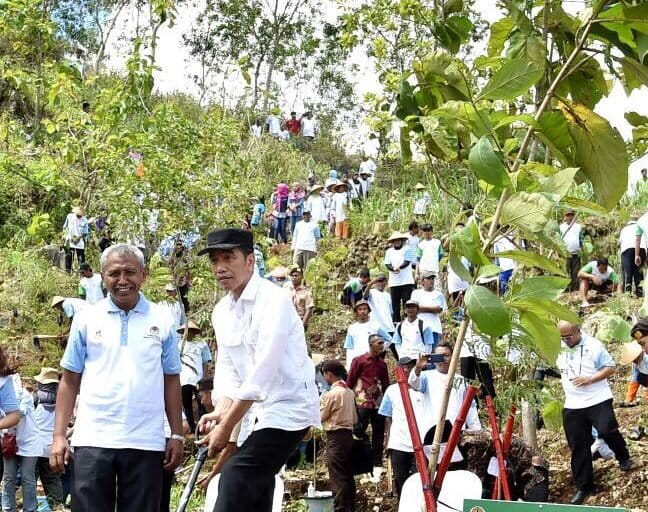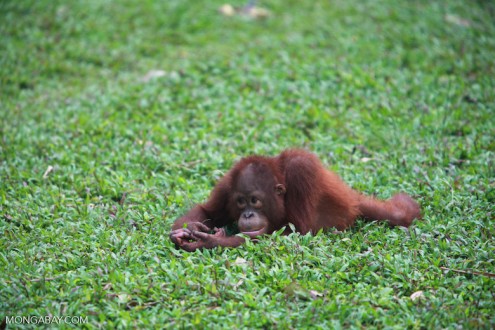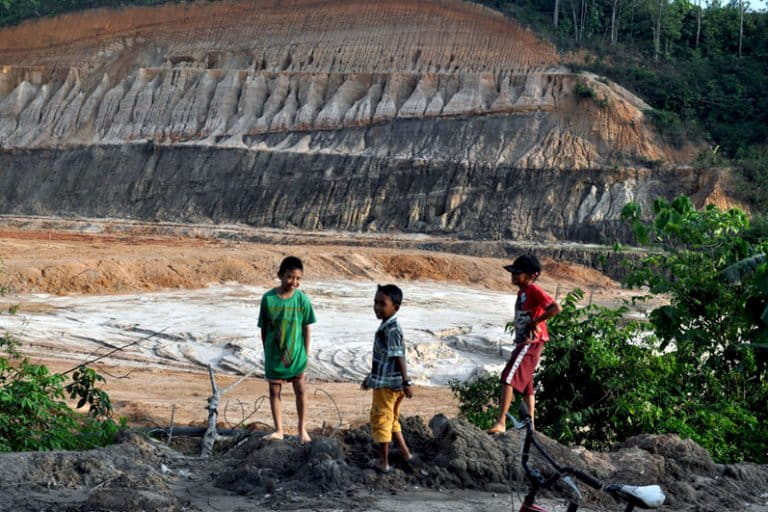- Indonesia’s efforts to reforest critically degraded land, left over from mining, logging and agricultural activities, have fallen far short of the government’s targets.
- The government initially sought to restore an area the size of the United Kingdom by 2030, before slashing its target to an area the size of England.
- Environmental activists have questioned how the government determines what constitutes land that needs to be restored, and say even an increased annual restoration goal combined with a tripling of funding is insufficient to meet the smaller overall target.
- Officials say lack of funding is the main impediment to the program’s success, and while an untapped pool of money is available, local officials are reluctant to touch it because of a history of mismanagement.
JAKARTA — Susilo Bambang Yudhoyono began his first term as president of Indonesia in 2004 with a pledge to plant a million trees a year, in an effort to make up for the massive deforestation the country had experienced over decades.
Five years later, following his re-election, he upped the ante to a billion trees a year. The idea was that this flourishing of foliage would help absorb carbon dioxide from the atmosphere and thus go some way toward mitigating climate change.
By the end of his presidency, in 2014, Yudhoyono claimed the government had planted more than 4 billion trees in the last four years alone, and called on the new president, Joko Widodo, to continue the program.
And in a way, Widodo has done so — but not before taking a swipe at what he saw as the previous administration’s scattergun approach to reforesting degraded land.
“If [we plant] 238,000 trees and all of them survive because they’re managed [well], that’s what we want,” he said in 2016. “What’s the use of planting millions or billions [of trees], but only two of them survive?”
Now, however, Widodo has been left fuming as his own ostensibly more systematic approach to reforestation has fallen far short of its target — even after officials scaled back the target significantly.

Focus on critical land
Reforestation is one of the government’s key tools for achieving its self-imposed carbon emissions reduction target of 29 percent by 2030 (or 41 percent with assistance from other countries).
If Yudhoyono’s approach to reforestation was pure arithmetic, Widodo’s has been more of a considered calculus. Where his predecessor prioritized the number of new trees planted, Widodo has focused on land area.
The government classifies the condition of land throughout Indonesia on a three-point scale: prime, degraded, and critical. It’s this latter category that’s been prioritized for reforestation, and it includes areas damaged by the rapid expansion of mines and plantations, as well as illegal logging and encroachment.
In 2013, the Yudhoyono administration had calculated the extent of critical land across the country at 243,000 square kilometers (94,000 square miles) — an area the size of the United Kingdom — and that was the number to hit by 2030 for the Widodo administration when it took over in 2014.
The reforestation achieved since then, however, has been negligible. Less than 1,000 square kilometers (390 square miles) of critical land was rehabilitated by the government between 2015 and 2018, according to figures from the Ministry of Environment and Forestry — less than half of a percentage point of the target.
If land rehabilitated through other means, such as mangrove planting and reforestation by private-sector concession holders, is taken into account, then the figure goes up to nearly 7,900 square kilometers (3,050 square miles).
“If we look only at the size of critical lands that have been rehabilitated, then each year the government has only managed to restore 200 square kilometers [77 square miles] on average,” says Bejo Untung, a program manager at the Center for Regional Information and Studies (PATTIRO), an NGO that keeps track of state and local spending.
Even Widodo seemed baffled by the glacial pace of reforestation, and chided his subordinates over it at the end of 2017.
“Year after year we exhaust our budget [to plant trees], but where are the trees? Can anyone show them to me?” he said during a tree-planting ceremony in central Java.

Moving the goalposts
With the reforestation target so far out of reach, the government decided in 2018 that it was aiming too high. So it slashed its estimate of critical land to 140,100 square kilometers (54,100 square miles), or about the size of England. (It will still take 48 years to rehabilitate even this smaller area at the current pace of progress, the Ministry of Environment and Forestry says.)
But that massive reduction in the target hasn’t sat well with environmental activists, who now question how the government determines what constitutes critical land.
“The new figure is quite surprising because it omits 100,000 square kilometers, or 42 percent from the 2013 figure of critical lands,” says Roy Salam, executive director of the Indonesia Budget Center, another budget-tracking NGO. “Why was this figure just revised in 2018? How did they come up with the figure in the first place?”
Ida Bagus Putera Parthama, the environment ministry’s head of watershed management and protected forests, says the initial figure was inflated to begin with.
“If we go by the past criteria, then savannas would automatically be considered critical lands,” he says. “But using our current criteria, savannas aren’t necessary critical lands because that’s just how their ecosystems are. The same applies for mountain craters.”
He says the figure was revised simply because the criteria for what constituted degraded and critical lands had changed.
“I have to stress that even though the figure has decreased, it doesn’t mean we’re claiming that as a success,” he adds.
Muayat Ali Muhsi, a member of a environment ministry task force on social forestry, attributes the problem to the lack of a publicly accessible map for the land rehabilitation program. He cites a case in West Kalimantan province, in Indonesian Borneo, where a local forestry unit was tasked with planting trees on land slated for rehabilitation.
“But they were confused because the local forestry office didn’t have the spatial data” for the land in question, Muayat says. As a result, no rehabilitation took place.

Triple the funding
Even as the Widodo administration slashed the total area of land it sought to rehabilitate, it more than tripled the funding allocated for the program, raising yet another red flag for observers.
Funding for the program went from 1.08 trillion rupiah ($76 million) in 2018 to 3.51 trillion rupiah ($248 million) in 2019. The environment ministry’s official in charge of climate policy, Ruanda Agung Suhardiman, says it was a lack of funds that hindered the government’s land rehabilitation program.
“To date, our reforestation budget has been very small,” he tells Mongabay. “And from that budget, the amount that goes to reforestation is very small as it is also used for other activities. But now, the [2019] budget will mainly go for planting trees, almost 80 percent of it.”
Ida Bagus adds that the increase is aimed at quelling any doubt about the government’s commitment to reforesting critical lands.
“Because the size of the land [that has to be rehabilitated] is massive, if we only plant a small number of trees little by little, then it’ll seem like we’re doing nothing,” he says. “So [the size of lands being rehabilitated] has to be big so that there’s an impact.”
But given what he calls a “drastic” increase in funding, combined with the persistent lack of transparency about which areas are eligible for rehabilitation, Roy from the Indonesia Budget Center says there’s a high risk the money won’t be put to good use.
“With no accurate data on critical lands, how will you utilize the budget?” he says. “Asking for 3 trillion rupiah in funding without a strong database in place could lead to budget misuse and affect the quality of the program itself. In the end, such a high budget could end up as another failure.”

Low new target
Then there’s the issue of the newly updated goal that the environment ministry has set itself for reforestation.
From 2019 onward, it aims to restore 2,060 square kilometers (800 square miles) of critical land annually — ten times what it averaged over the past four years.
“We will work hard,” says Siti Nurbaya Bakar, the environment minister. “The president has decided to increase our efforts tenfold through [increased funding from] the state budget.”
Yet as ambitious as this figure is, it still falls far short of the 11,000 square kilometers (4,200 square miles) a year of land rehabilitation called for under the government’s own mid-term development plan — a classic case of bureaucratic disconnect between government policies, says Roy.
“Since the beginning, the target set out in the mid-term development plan wasn’t included in the [environment] ministry’s work plan,” he says. “Why does the government set such a low land rehabilitation target when at the same time it says the size of critical lands is so huge?”
Siti has acknowledged the disparity, saying the pace of reforestation needs to be much greater to hit Indonesia’s carbon emissions reduction target by 2030.
“If we want to be safe in terms of climate change, then we have to plant at least 8,000 square kilometers [3,100 square miles] per year,” she says.

Local participation
Even in areas where land rehabilitation has taken place, reforestation efforts haven’t always been a success. The government says it targets 90 percent of the trees it plants surviving to maturity; the real number has been much lower.
The environment ministry’s solution to this is to monitor reforested areas for a period of three years, to ensure the newly planted trees grow properly, says Ruanda, the ministry’s climate policy chief.
“We’ve been asked by the president to really make sure that the trees are there [and not dying],” he says.
Various studies on the rehabilitation program have also found minimal public participation in reforesting, with local communities typically only invited to ceremonial tree-planting events.
Muayat, the social forestry official, says it’s important that these communities are also consulted on the kinds of trees to be planted, and given a bigger role in monitoring their growth. Without such participation, he says, they have little sense of ownership in the program.
“The process is closed to the public,” Muayat says. “Ideally, the decision on what kinds of tree seeds should be planted should be discussed with the locals first.”
Ida Bagus says the ministry will now involve locals from the start of the process to ensure the success of the land rehabilitation program from 2019 onward.
“People who live around the forests are such a huge part of our nation. So they very much decide the success of any program,” he says. “If they’re left out, it’ll mark the beginning of a failure.”
In addition to local communities, the government will also be leaning on the private sector to live up to its obligations to rehabilitate critical land. This includes mining companies, which are required to restore their concessions upon the end of operations. If they and the government hit their targets, the total area of rehabilitated critical land this year will amount to nearly 6,900 square kilometers (2,700 square miles).
That’s a big ask, given that currently less than 10 percent of disused mines in Indonesia have been rehabilitated, according to Ida Bagus.
“Companies tend to bide their time and wait until their permits are about to expire before they fulfill their obligations,” he says.

Untouched fund
If lack of funding is the main impediment to the reforestation program, as multiple government officials insist, there’s a ready solution that’s long gone untapped.
The government has since 1989 managed a reforestation fund, paid in through levies charged on logging concession holders. But much of the money continues to sit idle in government coffers; as of the end of 2018, the cash glut amounted to 4.8 trillion rupiah ($340 million), according to government figures.
A major reason officials are reluctant to dip into the fund is the fear that they might be accused of corruption, and with good cause. The fund was grossly mismanaged under the administration of the strongman ruler Suharto, with recipients marking up their costs and overstating their replanted areas. A 1999 audit by Ernst & Young found $5.25 billion in losses as a result of systemic financial mismanagement and fraud between 1993 and 1997, in the waning years of the Suharto regime.
Many officials were implicated in these cases of malfeasance, and their successors have since tended to steer clear of the fund.
“They’re worried they’re going to be implicated as well, because many [officials] have been arrested [for misusing the reforestation funds],” Muayat says.
That’s led to vast swaths of critical land going unrestored for lack of money. In North Kalimantan province, for instance, nearly 50,000 square kilometers (19,300 square miles) of mostly former mining concessions have not been rehabilitated, despite the fact that reforestation funds are available, says Obed Daniel, head of planning at the provincial forestry agency.
“Many regulations [prevent us from using the money] and many forestry officers have been implicated in legal cases due to the funds,” he told local media last year. “It means there are many in the local [government] afraid of using the money.”
In other areas, like the Mentawai Islands off the western coast of Sumatra, reforestation funds are also available, but there’s virtually no land that qualifies as eligible for rehabilitation.
That’s because a 2002 government regulation on the reforestation fund stipulates that only land for which no permits are in force may be reforested. As a result, 64 billion rupiah ($4.5 million) of restoration funds have been left unused in Mentawai alone since 2003, according to a local media report.
“Many local governments don’t know where to plant trees,” Roy says. “That’s why many reforestation funds are left unused.”
To address the problem, the Ministry of Finance issued a regulation in 2017 allowing local governments to use the reforestation fund for other purposes, such as firefighting and social forestry. Some local governments have done just that, using the money to buy fire trucks and firefighting tools, Roy says.
But many others are still reluctant to touch the fund because the 2017 ministerial regulation is trumped by the 2002 government regulation, giving it a shaky legal basis.
“The ministerial regulation is yearly in nature,” says Bejo from the budget watchdog PATTIRO.
To allow governments to make full use of the reforestation fund, the 2002 regulation needs to be revised, observers say. In particular, the money can be channeled to the government’s social forestry program, under which local communities are accorded land title and stronger management rights over the forests in their areas.
As it stands, the social forestry program needs annual funding of at least 800 billion rupiah ($57 million) per year, but currently gets just half that amount. Properly funded with money from the reforestation fund, it would complement the work being done rehabilitating critical land in a sustainable way, says Roy.
“The social forestry program at its core is also about land rehabilitation, as local communities restore and protect their lands,” Bejo says. “And the impact could even be greater [than a land rehabilitation program that doesn’t involve locals] because the social forestry program can also increase people’s welfare.”
Banner image: Indonesian rainforest in Bukit Tigapuluh, Sumatra. Image by Rhett A. Butler.
